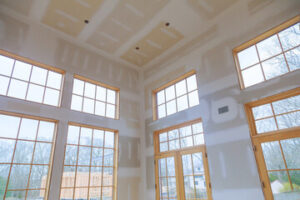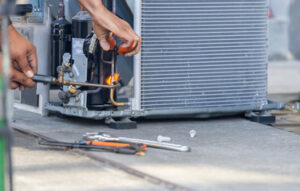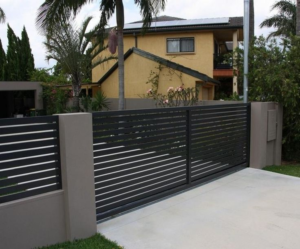A skilled drywall contractor is essential to any commercial construction project. They can ensure the drywall installation or repair meets strict building standards, reducing the risk of structural issues and costly repairs down the road.

When selecting a drywall contractor, it is important to consider their experience, portfolio, and reputation. This article will discuss tips for evaluating these attributes to help you choose the best contractor for your project. Click Here to learn more.
Drywall professionals offer a wealth of skills and experience that are invaluable to construction projects. They are skilled in the application of various materials and can help manage costs while maintaining quality. In addition, they are skilled at meeting the specific needs of a project, whether residential or commercial.
It’s important to choose a drywall contractor who takes the time to ensure every aspect of the job is done correctly. From sanding rough spots to filling nail holes, a good contractor pays special attention to details and makes sure everything looks perfect when finished. They also take the time to use the right tools for each task and provide helpful suggestions, ensuring that the work is completed quickly and efficiently.
A reputable contractor will communicate clearly and regularly, and they will provide you with detailed quotes before beginning the project. Make sure to compare quotes from several contractors, and always ask for a breakdown of labor, materials, and any additional fees that might be associated with the project. This will help you make the best decision for your budget and avoid any surprises down the road.
Professional drywall contractors are committed to providing high-quality work at competitive prices and will work to meet your construction deadlines. They will also provide you with an estimated timeline for the completion of the project, ensuring that your renovation or new construction is on track and doesn’t face unnecessary delays. They are also knowledgeable about the proper disposal and recycling of drywall materials, helping to minimize the impact on the environment.
There is a growing need for skilled workers in the construction industry, including drywall contractors. The National Association of Home Builders reports that the construction industry is facing a shortage of 16 different trades, including framing crews and drywall installers. Those who are interested in a career in the construction industry should enroll in a specialized program that provides hands-on training and instruction in a variety of building trades, such as drywall. To obtain an occupational license, you must complete a combination of classes and pass a series of exams administered by the State Board of Licensing.
Experience
A contractor’s experience is an important factor when selecting a team for your project. A seasoned company with a wide range of services has the skills and knowledge to tackle any job from small renovations to major remodeling projects. They also have the reputation to back up their work and will be able to provide references. You should ask for recommendations from friends and family, as well as look at online reviews. A contractor with a strong portfolio will be more likely to complete your project on time and within budget.
When evaluating a drywall contractor’s craftsmanship, you should look for smooth seams and consistent texture application. A reputable drywall contractor will pay close attention to details, such as nail holes and rough spots, to ensure a flawless finish. They should also have the experience to handle a variety of drywall techniques, such as taping, mudding, and sanding.
To become a licensed drywall contractor, contractors must pass a C-9 trade exam. This process can be lengthy, but it is an excellent way to determine a contractor’s level of expertise and ability to meet state standards. It is also a good idea to ask for a copy of their license and insurance certificate, which will help you protect yourself from fraud.
A reputable drywall contractor will be able to provide you with a detailed estimate of your project’s costs. They will also be able to explain their pricing model and answer any questions you may have. This will allow you to make an informed decision about which drywall contractor is the best fit for your project.
Drywall contractors can stand out from the competition by offering additional services, such as roofing. This can help them attract new customers and boost retention. Additionally, it can help them build a strong reputation in the industry and increase their profit margins. In addition, they can cross-train their employees in roofing and boost staff morale. They can also offer a full package of construction services, which can save their clients time and money. In the end, this can result in a more thorough service and increased customer satisfaction.
Reputation
A drywall contractor’s reputation and credibility are essential for building trust with potential clients. A good contractor will demonstrate their skills, professionalism, and reliability through a diverse portfolio that showcases past projects. They will also prioritize customer feedback and transparency when estimating costs for projects. Additionally, they should provide a clear contract and offer warranties on their work.
Drywall estimating is a complex process that requires specialized tools and software to ensure accuracy. Contractors who use these tools are more likely to deliver accurate estimates, which lead to smoother collaborations with clients and better project outcomes. Moreover, they can leverage the data generated by these digital tools to refine their estimating methods and make better business decisions.
When choosing a drywall contractor, look for online reviews and recommendations from past customers. These reviews will give you a good idea of the contractor’s reliability and work quality. Read through the reviews carefully and note any recurring themes. You can also check out a contractor’s social media pages to see how they interact with their audience. This will help you determine if they are the right fit for your project.
A good drywall contractor will have a solid understanding of the ins and outs of the industry. They will be able to handle all aspects of the project and will be able to meet your deadlines. In addition, they will provide you with a detailed cost breakdown for each phase of the project. Additionally, they will communicate with you regularly throughout the project and explain technical details in an understandable way.
In addition to accurate estimating, a good drywall contractor will have an extensive network of business connections. This will allow them to diversify their business and expand their client base. They will also be able to handle any unforeseen challenges that may arise during the course of the project.
Effective content marketing is a powerful tool for attracting and maintaining a loyal audience. To create content that resonates with your audience, it’s important to know your audience and their pain points. In addition, it’s crucial to create educational content that provides valuable information and answers common questions.
Warranty
Home improvement projects are a great way to enhance the aesthetics and functionality of your property. However, there are some key aspects to consider that can make or break the project’s success. One of these is the selection of a qualified drywall contractor. A professional contractor will play a pivotal role in the renovation process, ensuring flawless walls and ceilings that serve as the canvas for your newly designed living spaces.
The reputable drywall contractors will offer you competitive and transparent quotes for the work that needs to be done. It is also important to look for a contract that clearly describes the scope of work, materials to be used, project timeline, payment schedule and other essential details. This will help prevent any disputes or disagreements down the road.
A reputable drywall contractor will provide you with a warranty that covers their workmanship for a certain period of time after the completion of your project. This will give you peace of mind knowing that the contractor stands by their quality of work and is committed to your complete satisfaction.
Drywall installation and repair is a common part of most remodeling projects. This durable material has numerous benefits for homeowners, including cost-efficiency, versatility and ease of maintenance. It can be used in both interior and exterior applications, making it ideal for a wide range of projects. Moreover, it is fire resistant and can reduce sound transmission between rooms. In addition, it is easy to cut and shape to fit different architectural designs.
The most reputable drywall contractors will have a proven track record and are insured and bonded. Their years of experience and expertise will ensure that your project is completed in a timely and efficient manner. They will also take the time to inspect your work for any defects or repairs that may be necessary.
A professional drywall/plaster wall repair contractor will pay attention to detail and ensure that all joints, seams and cracks are properly taped and sanded to create a smooth surface for painting. They will also use high-quality materials to guarantee the longevity of their work.



